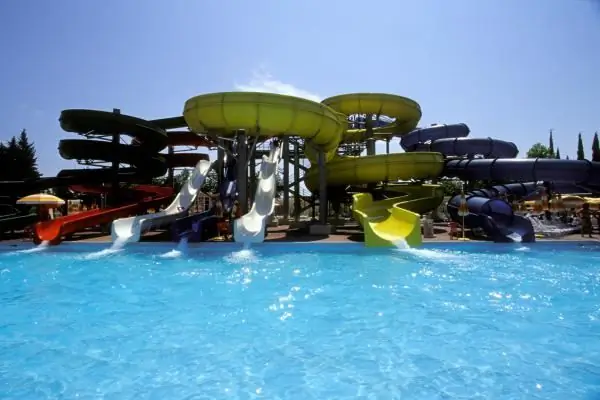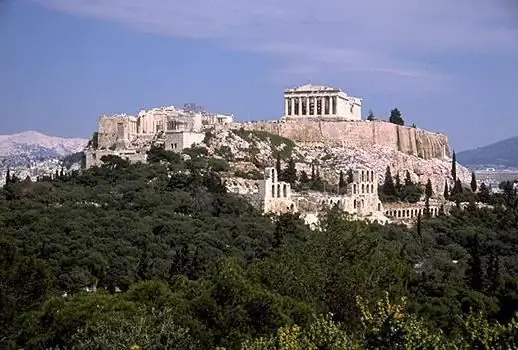- Author Harold Hamphrey [email protected].
- Public 2023-12-17 10:06.
- Last modified 2025-01-24 11:10.
Moscow region with richly preserved old noble estates, which are of interest to people who are fond of national history. Having visited and examined the wonderful architectural ensembles, tourists will feel the spirit of antiquity and get aesthetic pleasure from contemplating the most picturesque places.

One of the attractions of the Moscow region is the Goncharovs' estate (Yaropolets), located in the Volokolamsk district on the Lama River in the village of Yaropolye. Everyone who has ever visited these places speaks of its uniqueness, atmosphere and beauty. Reviews of tourists who have visited the estate indicate that the history of this place is still alive.
Historical background
What is unusual about the Goncharovs' estate? Yaropolets is an unusual village. This is confirmed by the numerous reviews of those who happened to be there. The estate was founded by the Ukrainian hetman Doroshenko on land received in 1684 from the Russian Tsar Alexei Mikhailovichfor the service. The name of the estate comes from a combination of the words "ardent field" and is due to the fact that hunting dogs were bred in this place. The estate is a whole complex of ancient buildings for various purposes, constituting an integral architectural ensemble.
The owners of the estate

Over the course of several centuries, the owners of the estate have repeatedly changed. It was passed on as a dowry and belonged to the Zagryazhsky and Goncharov families. It was here that the mother-in-law of the poet A. S. Pushkin, Natalia Ivanovna Goncharova, was born. The future wife and muse of the great poet, Natalya Goncharova, came here every summer. Alexander Sergeevich Pushkin, having married Natalya Nikolaevna Goncharova, also visited the estate more than once.
Before the revolution of 1917, the estate was owned by the Goncharov family. Thanks to the efforts of the last owner of the estate, Elena Borisovna Goncharova, a four-year zemstvo school was opened in the village of Yaropolye. Already in Soviet times, Elena Borisovna achieved the state registration of the estate as a cultural monument. In 1918, the Department for Museum Affairs and the Protection of Monuments of the People's Commissariat of Education issued a "protective certificate", according to which the estate was not subject to requisition.
Homestead during the war
During the Great Patriotic War, the village of Yaropolye was occupied by German troops. During the occupation, the estate was significantly damaged. Roofs and ceilings were destroyed. Part of the decoration of the facade was also lost. The biggest damage wascaused to the estate after the explosion of a German ammunition depot located in the immediate vicinity of the buildings. After the war, the estate of the parents of Natalia Goncharova in Yaropolets was in a dilapidated state for fifteen years. Local residents contributed to its destruction, dismantling building materials suitable for use. The state of the estate at the end of the forties of the XX century is recorded in the movie "On the Count's Ruins". In 1953, the mausoleum of the founder of the estate, Hetman Doroshenko, was dismantled. In general, the condition of the estate after the end of the war remained very deplorable.
New life

New life for the estate began in 1960 after it was handed over to organize a rest home of the Moscow Aviation Institute. At that time, it was restored according to a project created by the Mosoblrestavratsiya trust. The restoration was carried out taking into account the further use as a holiday home. At the same time, the park and adjacent buildings were not restored. In 1970, the Goncharovs' estate (Yaropolets) was completely restored and acquired its pre-war appearance. At the same time, many decorative elements disappeared from the interior, the premises acquired a different internal layout. During the restoration, modern materials were used, which made the interior faceless. The interior premises acquired a typical character, the historical appearance was not observed. Despite the fact that the restoration was not aimed at restoring the historical appearance of the estate, it generally played a positive role, and thanks to the work carried out,the estate in the village of Yaropolets was preserved. The Goncharovs' estate is a holiday home. Now here you can not only touch the history, but also have a good rest.
During the restoration, the "Pushkin Room" was put in order. The room is today the only one in which the historical interior of the 19th century has been preserved. Restoration work was carried out on the basis of photographs taken in 1937. The columns were restored thanks to a sample found by chance in the attic.
In the reviews of tourists, individual buildings on the estate are often mentioned. The Goncharovs' estate (Yaropolets) looks very attractive. The photo will not fully reflect all the grandeur of the structure.
Church of John the Baptist

What is now in the Goncharovs' estate in Yaropolets? The earliest of the estate buildings is a brick church, built in 1755 by order of the then owner of the estate, A. A. Zagryazhsky. The interior of the church has side entrances with stepped arches. The walls are covered with frescoes depicting biblical scenes. Divine services are held in the temple today.
One of the main reasons to go to the village of Yaropolets is the Goncharovs' estate. What other structures are located at the estate?
Master's House

In the course of the restoration carried out after the war, the interior of the manor's house was transmitted as authentically as possible. Thanks to the connection with the biography of the great poet, the Goncharovs' estate was preserved during the Soviet period. The master's house and the room in whichthe poet lived during a visit to the estate, was restored in accordance with the historical era. The house is connected to two outbuildings by galleries. The main decoration of the manor house is a portico of six columns. Behind it is a semicircular loggia. There is also a portico at the entrance to the park. The white decor contrasted well with the red brick walls. The walls inside the premises of the manor's house were originally decorated with murals depicting park views framed by borders. Interior design elements were borrowed from the interiors of the Arkhangelskoye estate. In the second half of the 18th century, an outbuilding was built opposite the temple, consisting of two floors. During its construction, special attention was paid to the observance of stylistic unity with the church. The two wings of the house are connected by a semi-rotunda and converge at an angle. Semi-rotundas and entrances are decorated with paired pilasters. The manager lived on the second floor of the wing. Today, all this can be seen in the village of Yaropolets. Manor of the Goncharovs - address: Moscow region, Volokolamsk district, Yaropolets village, st. Pushkinskaya, 19.
Stable body

The perimeter yard is surrounded by a metal fence with white stone pillars. The variant of the design of the manor complex with arched buildings is typical of the architecture of the 18th century. In the courtyard of the manor there is a carriage house and a stable. There is a bust of A. S. Pushkin in the center of the court-doner. Thus, the estate of the Goncharovs (Yaropolets) is an excellent example of the estate architecture of the classicism era. Buildings and structures areharmonious, holistic architectural ensemble. The most expedient option for the further use of this unique monument of domestic architecture would be to continue restoration work and turn the estate into a museum of landlord life of the late 18th - early 19th centuries. Restoration work carried out at a modern level would help restore the buildings to their historical appearance and recreate the atmosphere of life of bygone eras as much as possible.
Weaving workshops
On the territory of the estate there were industrial buildings. To date, weaving workshops erected at the end of the 18th century, representing one-story buildings, with ends overlooking the cour d'honneur, have been preserved. The workshops were decorated only from the ends. The presence on the territory of the estate of various buildings for industrial and economic purposes is typical for a landowner's estate. Production was aimed at meeting the needs of the owners of the estate, and part of the production was sent for sale and became a source of income. With the exception of weaving workshops, production buildings have not been preserved. In those days, the village of Yaropolets flourished. The Goncharovs' estate also contributed to this.
Park
Initially, judging by the surviving plan, the park was small and located in front of the house. Alleys fanned out from the center of the park. There was a greenhouse in the park, in which numerous varieties of fruit trees exotic for the Moscow region were grown. The best part of the park was the mountain above the Lama River. There were various figures on it, and all of it wascovered with sod. At the end of the 18th century, the figures decorating the park were removed. A fence was installed along the perimeter, which was a fortress wall made in the Gothic style. The fence was decorated with portals and towers built of red brick and decorated with white details.
Unusual buildings
To date, a part of the wall that separates the estate from the village of Yaropolets has been preserved. The Goncharovs' estate is located near the river, near which the ruins of a two-story building, erroneously called a hunting lodge, have been preserved. There is an assumption that in fact this building is a Masonic temple. This statement is based on the fact that one of the owners of the estate - B. A. Zagryazhsky - was a freemason. However, the absence of Masonic symbols on the building suggests otherwise. Thus, the purpose of this building is not reliably established. Designing the park ensemble of the estate, the architect managed to harmoniously combine the two styles. Buildings created in the style of classicism are organically complemented by Gothic structures.
Unfortunately, not a single sculpture that served as an adornment of the park ensemble has survived to this day. Also, the two-story theater located near the estate has not been preserved.
How to get to the estate?

Judging by the reviews, tourists are especially attracted by the picturesque area, surrounded by which the estate is located. At present, numerous trees (poplars, birches, lindens and larches) grow on the territory of the former park, apparently planted duringthe construction of the estate. The only surviving linden alley, called Pushkinskaya, leads to a round island surrounded by a canal connected to the Lama River. Such a wonderful place is the Goncharovs' estate in the village of Yaropolets. How to get to such amazing places? By car, you should move along the Novorizhskoye highway. After 100 km there will be the city of Volokolamsk. After passing it, you should move to the village of Yaropolets, which is 10 km away from the city.
Thus, the Goncharovs' estate, being one of the brightest sights of the Moscow region, can be recommended for visiting by tourists who want to touch a piece of the historical past of our country.






